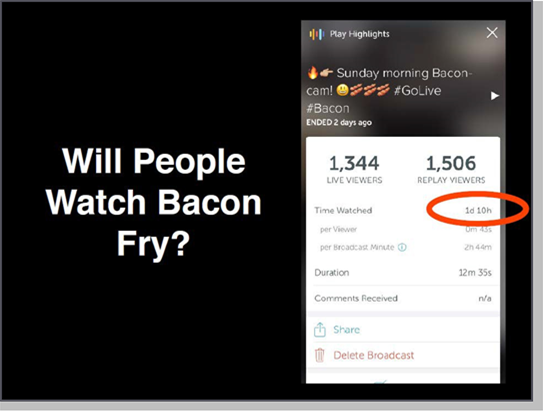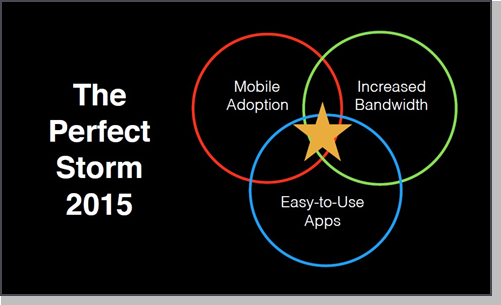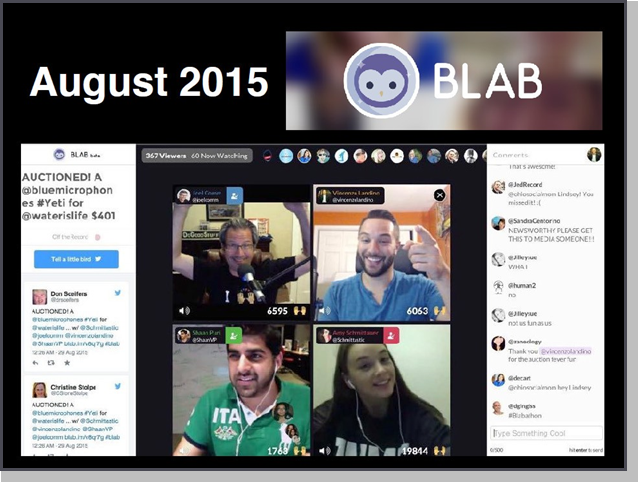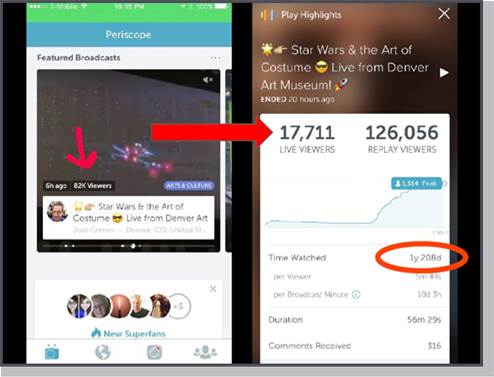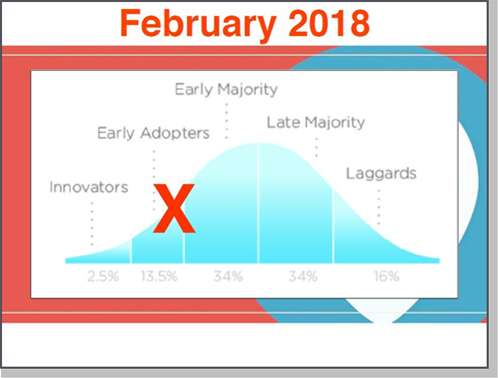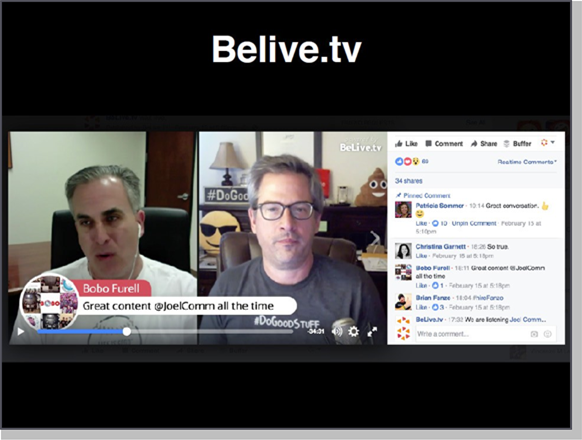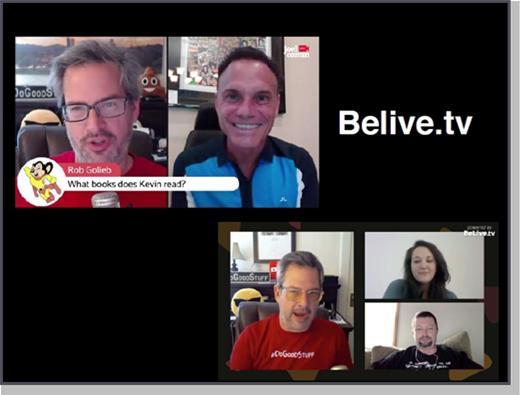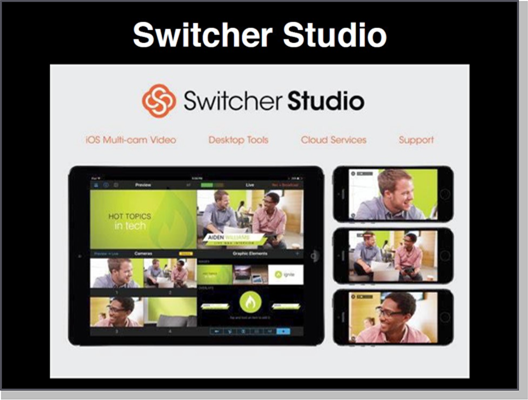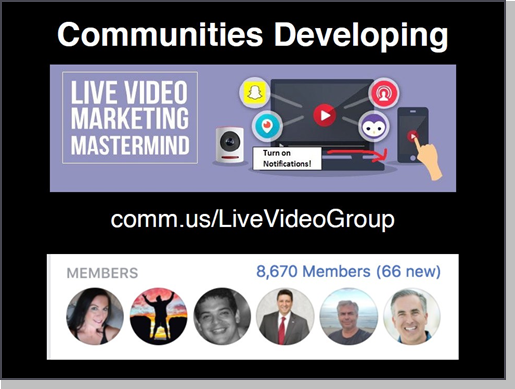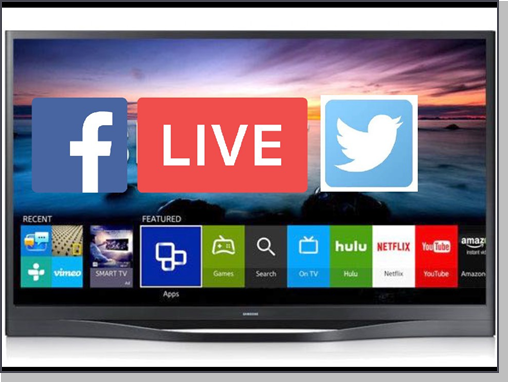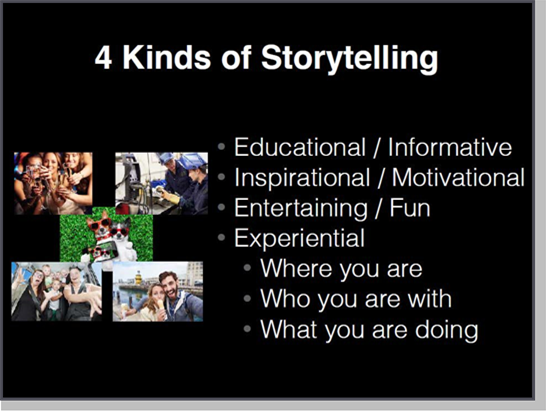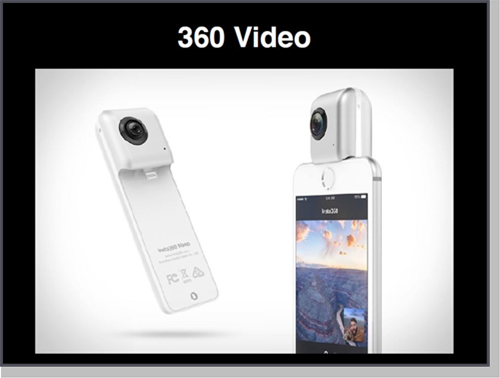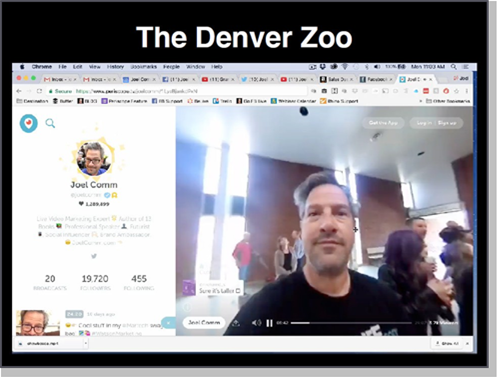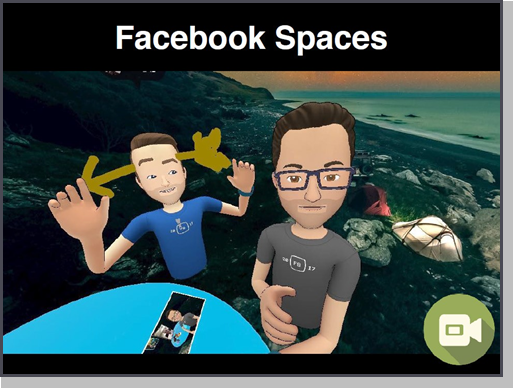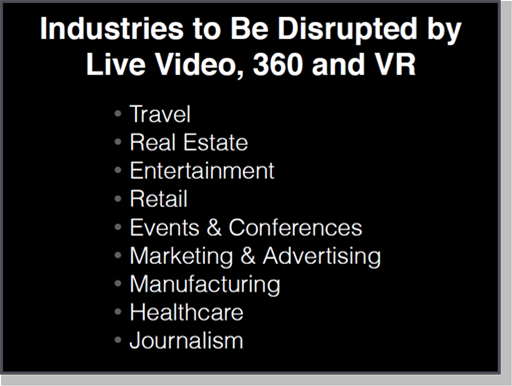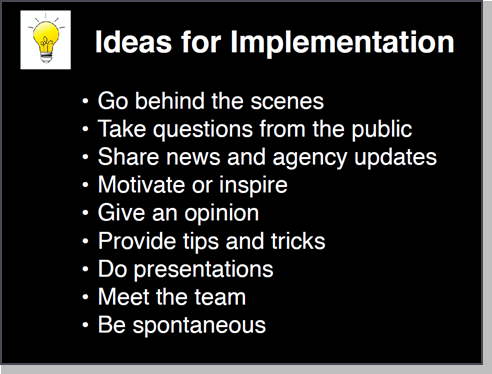Joel Comm
Joel Comm is a NY Times bestselling author, professional keynote speaker, social media marketing strategist, live video expert, technologist, brand influencer, and futurist. With over two decades of experience harnessing the power of the web, publishing, social media and mobile applications to expand reach and engage in active relationship marketing.
Today we are going to talk about the live video revolution, but first let me tell you something about myself. I’ve done a lot of serious stuff in my career. I am the author of 15 books, creator of Yahoo! Games, and the number one iPhone App Developer. I am a reality show producer, a podcast host and a marketing strategist. But deep inside, at the core, I believe in having a positive mindset and living your life to make a difference. And I like to have fun and keep it real!
Do you remember the app back in the day called the iFart app? You hit a button, and it just made a farting noise. That was me.
Now here’s one more thing, and I want you to know is this one, don’t let the looks deceive you, I am 12. It kind of goes with the having fun part. If you’re going to invent an app called iFart, you have to be eternally 12 years old.
Believe it or not, that app went to number one in the entire world. Flatulence sells.
And believe it or not, that relates directly to the topic at hand – live video and how we can use live video to create massive engagement and ultimately make more sales.
So, one day, I was home in Denver, Colorado and I decided to do an experiment. I took the camera out, put it on the tripod, and pointed it at the best thing on earth. Bacon, Baby! I didn’t say a word, because bacon does the talking for itself. No comments, no engagement with the audience, I just thought, “Will people watch bacon fry?” It was actually a 12-minute live video on Periscope.
Okay, so the question I had was: Will people watch bacon fry? And the answer is, during that video, 1344 watched live, 1506 watched the replay and I sucked a day and 10 hours out of the Internet. It’s bacon!
This is why I believe that live video is the most significant development in social media since the invention the smartphone over 10 years ago. Because there’s a lot we can do on this device and there’s a lot of social we can do on this device. But nothing has the ability to instantly connect with your audience like live video does.
What I want to do today is tell you where we’ve been in the live video space, then we’re going to talk about where we are right now. And then we are going to the future, Marty! And we’ll talk about where I believe we are going. Are you with me? Love it.
Live Video – Where We’ve Been
Once upon a time, when I started doing live video back in 2008, we had sophisticated camera gear, and we had to have a T1 for bandwidth. We had to have somebody who could produce and manage putting the video out. In 2008 we were doing Ustream.tv from my office in Loveland, Colorado.
It was complicated to go live back then, but what happened in 2015 was the perfect storm of live video. We finally had mobile devices in everybody’s hands, we had easy to use applications and because technology had advanced so much, we could go live on as little as 4G and LTE, let alone on Wi-Fi. And so, the revolution of live video began.
I remember getting on Meerkat when it was first announced at South by Southwest in March of 2015 and myself, Brian Fanzo, and Brian Kramer, were riding around for hours on the little carts through South by and videoing everything because, all of a sudden, we could be live just on our cellular network. Unfortunately, the Meerkat is no longer with us, he was killed by its other siblings, mainly Periscope, which came along soon after and was acquired by twitter. Of course, there’s Facebook Live to blame, too. Mark Zuckerberg likes to kill all the things in his path. He looks innocent, but his guy’s an evil genius.
For those of you who missed Blab, sorry you missed part of the early phase of the live video revolution that we have not seen again. This was the first time we had a platform where we could go live and host other people and do shows. It had a community unlike any that we have seen since that time. So, for those about to Blab, I salute you.
Here’s the moment that changed everything for live video, there was one moment where live video came alive and we all realized, wait a second, not only is this thing here, but I can do this, too. Anybody want to guess when that moment was? Candice Payne, known as Chewbacca Mom. Candice goes to Kohls’ department store. She goes shopping for some stuff and runs across this Chewbacca mask and thinks, “Oh, I’m getting this for me.” She goes back to her SUV, goes live on Facebook, un-boxes it and this happens – in a matter of days, it went viral and had over 140 million views
Her laughter is so infectious. They should play that video at the mortuary for those they say are dead to check to make sure. Like, play this, and if you really don’t have a pulse, you won’t laugh. It’s just contagious. And here’s what we discovered from this. Look at the numbers – 158 million views, by the way, it’s over 170 million now. There’s 2.8 million reactions and almost 3.5 million shares.
Here’s what we learned from Candice: When it comes to live video, you might think, “Oh, well, I’ve got to have the beautiful set. I have to have my hair and my makeup on point. I need a script.” Guess what? Candice showed us that your set doesn’t matter. She was in the front seat of her car. Hardly a set. We learned that hair and makeup doesn’t matter. And we learned that you don’t need a script to go live.
Now, for some, this could be intimidating. I think it’s liberating because we’re so used to having to have everything spit and polished to make it look like we are perfect somehow.
I went to the Denver Museum of Art and I turned on my Periscope because they had a Star Wars costume exhibit there. I went live, and look at these numbers. Just by sharing an experience of where I was with a subject matter that I thought was interesting. There were 17,000 live viewers, so many that Periscope went, “Hey this must be interesting, let’s put it on the feed.” And I sucked a year and 208 days out of the Internet just by showing Star Wars costumes and making commentary.
Live Video – Where We Are Now
Live video is here and it’s powerful. That’s where we’ve come from. This is where we are right now. In terms of technology adoption, this is the technology adoption curve that works for any type of technology. It’s a standard bell curve.
On the far-left side, you have the innovators or the pioneers. Then you’ve got your early adopters and then the masses come in and you have the majority, late majority, and then your grandma that’s still trying to figure out how to work her VHS recorder, and will never be on live video.
I believe we are right about where the big X is. We are still not at mass adoption for live video, and you know what that means? Opportunity! Opportunity is here, and this is why I believe live video is the most significant development in social, because where it’s going to go. There’s a ton of apps out there and Periscope and Facebook have really been the primary kings in the marketing sector.
Periscope is also Twitter Live. At some point they’re going to kill the Periscope app dead because now you can just go live using the same technology in the Twitter app itself. And of course, we’ve got Facebook Live. We can go live on Facebook several different ways in our mobile browser, or on our desktop now, or using some third-party tools that we’ll talk about here in a moment. Facebook even began integrating two-person broadcasts.
We haven’t gotten any new numbers from Zuckerberg since last year, but in April of 2017, we were told that 20% of all Facebook videos are live videos. That’s significant and, of course, it’s no surprise Facebook is moving full on into video. Have you ever seen a show on Facebook Watch? Do you have one? It’s going to be big. What’s television again? Yeah, there’s no such thing anymore.
Live Video Streaming Tool – Zoom
Now there’s a number of ways that we can push our videos through to Facebook and one way people have been doing that is by using Zoom.
With Zoom, you can have a bunch of people on there. Bandwidth tends to be a problem the more people you get on there, but it allows you to push videos through.
Live Video Streaming Tool – BeLive.tv
However, a little over a year ago, I discovered BeLive.tv. If are serious about getting into live video and haven’t used this, you are going to. I love the service. This allows you to bring a guest to Facebook Live through their interface, but it’s built for Facebook.
If you’re broadcasting using another service, like Crowdcast, for example, or Zoom, they have button that says, “Okay, now I want to share that to Facebook.” These guys have actually integrated their program with
Facebook. They were the first ones to integrate, to allow you to do two, then three-person, and now, just this week, four-person broadcasts to Facebook Live using their tools.
I love the service so much that they approached me last summer and said, “You use this thing all the time, do you want to be a brand ambassador?” And I said, “Yes!” So, I get to be a brand ambassador for BeLive.tv, but I want you to know I was using them and loved them long before that took place.
All you do is, you go to BeLive, you connect with your Facebook account, then you put in your title that you want to appear. Connect it to your email, then you can upload an image. If you’ve seen on Facebook when you’ve scheduled your broadcast, it gives you the rectangle, but then a little profile I hate that. Why can’t I put a full picture there? But you can schedule your broadcast ahead of time and it shows up just like that. Whatever text you put in becomes a Facebook post. You can go live right away, or you can schedule it to go live at a certain time.
So far, the Facebook native two-person tool only works one way. First of all, you have to be on an iPhone, and so does your guest. If you ever go live on Facebook, and you see the people who are watching your broadcast with a little green dot by them, that means that you can tap them and invite them onto your broadcast to be your guest. But it doesn’t do it on Android, and it doesn’t do it on desktop. These other technologies have gotten there faster.
This is what it looks like: There’s my friend Michael Stelzner. What’s interesting about this is, through the BeLive interface, I see the comments that people are making on Facebook, and I simply click on that comment and it stylishly shows up on the website.
So, it looks cooler than what Facebook has natively, and now they let you do things like create frames that are custom, you can put your logo in the upper right corner, and I promised this guy there would be a poop emoji in the presentation and there it is, there’s ‘Bob the Poo’ right there.
By the way, speaking of sets, this is my home office. You also got some people that are doing some cool green screen stuff, and that’s fine. there’s nothing wrong with that if you want to use the technology. This is how I roll, though. And you know what people connect with? They connect with the authenticity of that moment. Regardless of who we think anybody is, you know, it’s great that I get this nice build up when I come on stage, but we’re all the same. Just because I’ve written some books and have been playing in this sandbox for a while doesn’t make me any smarter or better than anybody else. Everybody here’s got something pretty damn cool to say. So you’re all worthy of the same type of accolades. Going live on Facebook is a way to share that information with people.
You can see there, they’ve got the three-person broadcast and they’ve just rolled out that initial beta of four person broadcast this week. I’m pretty stoked for that.
Live Video Streaming Tool – Switcher Studio
Another tool that I’ve been a fan of is Switcher Studio. This is useful if you’re going to do any type of video where you require at least two cameras. The old school way was to use the big cameras in there and have your crew.
Switcher is an app on iOS, and basically, if you have more than one iOS device, all of a sudden you have a studio. I’ve used an iPhone, an iPad and an iPad mini, and they act as a camera that I can switch on the fly in the app to do multiple camera angel stuff. It comes out looking really cool. I’m a big fan. I like to use it for unboxing videos. You set one of your devices on a mount over the box, put another one on you, and the other is the portable camera. With this you can do this unboxing on the fly and add a new element to it that’s not that single view that we’re used to. You don’t have to edit it because you’re doing it live.
Gear Choices for Live Video
Live videos also brought us a bunch of new gear choices. For example,
the Mevo, this is a camera that is designed for live events. It’s a camera, but through the app, it can actually focus on any point within the field of vision. You simply tap on it and it will go from your face to a wide shot. It’s a great event camera. When you’ve got two or more people on stage, it connects to your iPhone audio and away you go. I think they’re about $300 right now.
We’ve also seen a whole industry sprout up around the mounts that are needed so we can go live. We’re not lugging those big cameras, we have our iPhones and our Android devices, that’s all we need. It boggles my mind to think that the camera in this our mobile devices is superior to those little web cams. You know, those little handy cams we used to hold with tapes in them?
As long as I’m dating myself, I’ll tell you this story. My first computer was a TRS80 Model 1, with 4k of RAM. Oh, that baby was smoking fast. No hard drive. Hard drives at that point, like a 10-megabyte hard drive, was about $800, and the floppy drives were about $400. I couldn’t afford that because I was 16 years old, making pizzas and submarine sandwiches. But I was a total nerd then, and I’m still a total nerd now. But to play a program, you had to connect a cassette player and hit play and type “load” and it would go through. To dial in pre-Internet, to bulletin board systems, you had to have a modem coupler which would go, “do do do do do do,” and then you’d hear, “eeeee.” And then you put it on the coupler and I was dialing into BBS’s at 300 baud.
Technically, I have been dialing into the online world for 38 years. Now I really feel old.
Live Video Communities
We’re also seeing communities develop around live video. In fact when I started really talking about this about three years ago, I created a Facebook group, that’s free, it’s the Live Video Marketing Mastermind. We’ve got about 8,000 or so members, and this is where people are discussing their tips and their strategies. It’s amazing when you’ve got a group of people that are passionate about a subject like live video.
The ideas that come out of masterminds are just absolutely phenomenal. There’s other groups out there as well. Just search Facebook for them.
Video Story Apps
Now, I put puking rainbows and story apps in here for a reason. How many of you are using Snapchat? How about Facebook Stories? Instagram Stories? WhatsApp Status? I put these apps in here because although they’re not necessarily live in and of themselves, they feel live. We consume them in a way that is very similar to live. So of course, we’ve got Snapchat, which has done some interesting things. I was bullish on Snapchat a couple years ago and the bull has left town. I am no longer bullish. Though, I do enjoy the fact that my bitmoji can cycle through Denver International Airport, and he can make it rain in L.A.
Snapchat is a great deal of fun. I do not understand why they have not implemented a live feature yet. You know, every year they come to us marketers and they say, “What are your predictions for the next year?” And so in 2016 and 2017 I predicted that Snapchat is going to go live. They’re going to have a live feature. They’ve got these glasses and you’ll be able to go live through them and see the world, and they haven’t done it yet. Maybe they should listen to me because they’re not doing too great.
Facebook Stories is another angle, and of course Facebook Stories is owned by Facebook. We’ve got Instagram Live and Instagram Stories, and of course, Instagram is also owned by Facebook. And then we have WhatsApp,which on our side of this hemisphere, there’s not as many people using, but
they’ve got 1.2 billion users. So those aren’t small numbers. In case you didn’t know, it’s owned by Facebook.
What does this mean? It means Facebook and world domination.
Live Video – Where We Are Going
That’s where we are right now. You know where we’ve been. But we’re going to the future!
This is what the future is going to look like. The battle is on between the biggies. Of course, Facebook and Instagram, even though they’re the same company, they are battling it out. Twitter is battling for their piece of the pie. YouTube we should throw in there, too. It’s a cage match between all of them. What we need to understand is that the greatest success for these sites is going to come as they master EPM. Eyeballs Per Minute. Trademark Joel Comm.
How long can they get people to watch and stay and tell others so that they will watch and stay? New media is the new television. In fact, most of you probably have a smart TV. Your smart TV will soon, if it doesn’t already, have that on it, as Facebook Live enters into your living room or into your bedroom (not via a tablet or a phone).
And if Twitter doesn’t go ahead and get a deal done already, they’re toast. I don’t understand it. Come on, Jack! What’s going on there? Twitter Live should be showing up on your smart TV soon, as well. I think this is where it’s going as the convergence of media continues to take place.
The kids that are growing up now. When they say, “I’m going to watch TV,” do they mean they’re going to go over to the television set and turn it on? No. For them all media is TV. Whether they’re watching Facebook, videos on their mobile device, YouTube on their computer, or they’re getting Amazon Prime, Hulu, Netflix, or god forbid, a network show, they don’t know the difference. It’s all media. It’s all television to them and the merging of it all is happening.
We talk a lot about technology, but what I really want to bring home is that none of this is about the technology at all. What it’s about is the content that you create, and it has to be authentic. We talk about keeping it real? There’s never a better time and place to keep it real than when you’re doing live
video. You need authentic content plus engagement with the audience because when you’re going live, you see their comments, you see their reactions. You get to scrap that third wall and speak with them and have a dialogue.
It’s like your Facebook page without all the trolling. Well there’s some trolling. A little bit more on Periscope than on Facebook. But imagine, we go live and in just few seconds, people can be watching from another state, another country, on the other side of the world.
Have you ever heard of John Kapos? You guys need to know ‘Chocolate Johnny’. He’s a good mate. Lives in Sydney, Australia, third generation chocolatier. He owns a chocolate shop there in Sydney and he goes live on Facebook and Periscope. He is Willy Wonka. He shows people how the chocolate is made, and he has fun. Go follow Johnny. Johnny does a fantastic job of engaging with his audience. They will ask him questions and he will address them and answer them.
There are so many things that we can do with Facebook Live that we can’t do with recorded video or just posts.
Here’s the formula: authentic content + engagement with your audience = relationship.
That is what it will always be about. It is what it has always been about and if anybody tells you it’s about the latest doodad or gadget or version of an app, they’re missing the whole point.
We knew how to build relationships long before we had this technology. Now that we have it, how do we harness it to deepen these relationships? The only difference is before the technology, if I wanted to build a relationship with somebody on the other side of the world. I’d have to pick up the phone and spend a ton on a long-distance call or I’d have to write them a letter that they’d get in several weeks. Remember that? Writing, you know the thing with the pen and the paper? Yeah, that.
I’m actually really glad for technology because my handwriting has always been horrible. Horrible hand writers of the world unite! We can type – it’s beautiful.
I hear a lot of people talking about wanting to make their videos go viral. Pro
tip: You don’t make viral videos. You don’t create viral campaigns. What you do is you tell a story that is so compelling that other people will retell that story for you. If anybody ever says, “We’re going to help you with viral marketing.” The question is, “How are you going to help me tell a story that is so compelling that others will retell it for me? Without spending money on Facebook ads.”
That’s how compelling you want your stories to be. And so ultimately, your live video is about story telling. You’re all story tellers. The moment you go live. You are a story teller. Well you might say, “I don’t know how to tell a story.” Yes, you do. You called your girlfriend or your boyfriend or your spouse or your child and you told them what happened today. You’re all story tellers.
Four Kinds of Story Telling
Let’s try and frame it in terms of four kinds of storytelling.
Educational/Informative
The first is educational or informative, so we speak to the mind. Tell me something I don’t know. Teach me something that I did not know before I tuned in to your live video. Does anybody here not know something? I’ve had that in my life, too, where I don’t feel like I know anything. Speak to the mind for educational and informative videos. Alright, we’re done with the mind.
Inspirational/Motivational
Now we’re going to speak to the heart. Inspirational, motivational storytelling, stories that move people in a human way. It’s one thing to implicate knowledge and information, it’s another to move the human soul with your story telling. Whether that’s laughing or crying or any of the other emotions in between. Inspire people, connect with them.
Entertaining/Fun
The third type of storytelling is entertaining, or fun storytelling. Now you could be a professional or an amateur entertainer – guitarist, vocalist, comedian illusionist, juggler, anything. Stupid human tricks – whatever it is that you do. It could be your dog. Your dog could be the whole entertaining thing. For crying out loud, bacon’s entertaining! At least to some people it is. Entertaining and fun videos is the third type of storytelling.
What I’ve discovered is, when I go live, I don’t stop and think, “Is this going to be informative? Is this going to be inspirational? Is it going to be entertaining?” Because just in the natural process of telling stories, it’s all those things. You bring it all in.
Experiential
If all else fails, if you don’t know what else to do, then experiential live videos are so simple. I showed you two examples, the bacon frying and a trip to the Denver Art Museum to look at the Star Wars exhibit.
Experiential videos break down to this: where you are, who you’re with, and what you’re doing. Can you do that? I’m sure you can. If something is interesting enough to you, that you want to share it with the world. That’s when you can go live from wherever you are. As long as you’re not violating any copyrights or trademarks or any of that good stuff.
Go and show people what you’re experiencing, and it’s storytelling and it’s real and it can be raw and it can be in the moment. Some of us are looking at the latest technology and going, “Well, where is this heading? How do I do even more compelling storytelling?”
Anybody purchase a 360 camera yet? These things are great. This is an insta360 nano, they are about $200. They work on your iPhone, you simply turn the phone over, plug it into where you would charge your phone, and there’s an app that goes with it.
This is actually a video that I shot at the Denver Zoo. I don’t know what it is with baby giraffes. But if a city gets a baby giraffe, everybody’s gotta go see the baby giraffe. Well, it’s even better in 360. This was on Facebook and I’m actually just clicking around with the 360 camera, you can show people what you are experiencing in that moment and bring them into the experience in a more intimate way.
I don’t know how many people watched this thing, but there was quite a few – 360 is immersive and it brings you into the experience. The goal of the live video is to share an experience with somebody and to make them feel like they are there, then 360 video is a way to do it. Now you can do it with YouTube, you can do it with Periscope and Twitter and you can do it with Facebook – it works great. It’s a lot of fun.
Anybody in here purchased a HTC Vive or an Oculus Rift? So, when we think of that technology adoption curve, we have a room full of people that are using technology and only a few hands went up when we are talking about virtual reality. This is coming. And when it comes, it’s going to come fast and furious. The technology is getting better and better. I purchased an Oculus Rift just about two years ago and it really is an immersive experience.
Live Video – Practical Applications
So, what are the practical applications for us when we look at live video? Well, for example, who is tired of not being able to get seats to your favorite concert because of the scalpers that are charging outrageous sums of money to profit off us music lovers? Well, there’s now a company that is working with certain bands. NextVR is one of the companies doing this. They are doing stuff with Imagine Dragons and others where there’s a live show and they put cameras, 360 cameras throughout the venue and you put your headset on, put your headphones on over them and you have a front row center seat for that live show that’s happening right there.
I was really upset because you know last year we lost a lot of rock greats. We lost Tom Petty, and Tom Petty did two shows at Red Rocks, Colorado, which incidentally is the best outdoor venue. If you ever come to Denver just say to whoever is there with you,“Take me to Red Rocks, take me to a show at Red Rocks.” A musician’s dream to play there. The tickets were sold out. They were scalping them starting at $600. If I had had something like this, where I could experience the concert for the price of the pay-per-view, because I couldn’t go at a reasonable price, it would be fantastic. This is the future. This stuff is happening now.
Sporting events. Any sports fans in here? Any football? Imagine cameras throughout the stadiums and arenas in all 550-yardlines and end zones, up above hanging from the blimp. And you’ve got your VR on and you are watching that game and picking which camera and which view and you’re following that ball. You’re like, “Whoa!” There could be a camera in the helmet of the running back. They’re going to be able to do cool things that, and are going to immerse us in to that live experience unlike any other. It’s going to be absolutely amazing.
Pretty soon, y’all won’t look like avatars to me, you all look like real people. These avatars are going to get more sophisticated and, in the future, not too distant, you will be going to virtual events. As I’m walking through the virtual hallway of the virtual conference center, and I get closer to your virtual avatar, our volume automatically increases. You will look like you, and I’ll recognize you instantly. We’ll have a conversation in this virtual space.
That said, I hope that none of this ever replaces people getting together at real live events. This needs to happen. This is the smartest thing that you could do for your business is be at an event. In fact, I have people ask me all the time, “If you were starting over today with your business and you had nothing, you didn’t have the reputation you have now, and you didn’t know what direction you wanted to go, but you knew what value you could bring. What would you do?” I’d say, “I’d show up where there’s people. Where there’s people, there’s problems, and with those problems, I might have the solution.”
These virtual events are going to be coming and, in fact, we’re starting to see in VR some examples of people meeting in cyberspace. Facebook has recently rolled out their first version of Facebook Spaces. It’s their first social app. Where you can go into your space, create your environment from pictures on the Facebook feed. Watch videos, play games, in fact, this is my friend Bob Doyle, and Bob and I went into spaces using a tool, and I was able to put the camera of my webcam on myself in the lower right corner.
This is us in spaces.
I can invite up to four people into this space with me and we can watch a video in full immersive 360. We can have a conversation. If somebody messages me while I’m on Spaces, in Messenger, it shows up on my little watch and I can talk to them, so I can engage with people. I can go live from Spaces as my cartoon avatar and people engage with me the same as though a camera was on me. It’s super great fun and this is where this stuff is headed.
Facebook’s taking it very seriously, Zuckerberg paid a couple billion for Oculus, and now they’re rolling out this Oculus Go, which doesn’t require a fancy computer and expensive gear to make it work. It’s my prediction. I hope I nail this one. Even though I didn’t nail Snapchat going live yet. The holidays 2019 is going to be the year of the VR breakthrough. The year of the Tickle Me Elmo for VR.
Software sells hardware. You don’t buy the new Nintendo just because there’s a new Nintendo. You buy it because there’s a new Mario game that somebody has to play. There will be an experience in VR that will be so compelling, it will be like Pokemon Go!
There will be a software application so compelling that people will go buy VR. I’m going to say holidays 2019. It’s going to happen.
Let’s talk a little about the disruptive nature of live video. Here’s just a handful of some of the industries that are going to be disrupted by live video, by 360, and by virtual reality. Travel. This is like the Captain Obvious stuff right here.
To be able to go places through video. To be able to take people places. If you are in the travel industry, and you are not showing people when you are somewhere, where you are, what the cool things are that are happening in that city, you’re missing out on all kinds of sales opportunities.
Real Estate. Realtors are some of the first ones to pick up on this. You want to do a showing of a house? Go live, walk people through it. Now they don’t have to be there. You can have hundreds of people watching on your page while you’re walking through the house. Do it in 360, and they can tap around and look wherever they want to look in that house. This is going to change the real estate industry.
Entertainment. We already talked a little about that.
Retail. Retail is going to change. Now I can go shop in your store, you got a camera up in the middle, and I can zoom in, and I can look over here, or I can walk in virtual reality and pick that up off the shelf and click on it and read information.
Stuffs going to happen. It’s like Minority Report, you know where Tom Cruise walks through the store and they totally recognize who he is and say, “Your suit is in Mr. Cruise.” Events and conferences are going to be disrupted by all of this – marketing, advertising, manufacturing. Any industry you can think of can be disrupted by the ability to instantly connect with an audience using live video. Journalism, even though it’s kind of dead, maybe live will bring it back again.
Ideas for Implementing Live Video
So, here’s a few quick ideas for you before we finish up today.
If you’re going to do live video, go behind the scenes, like Chocolate Johnny and his chocolate shop. Perfection Chocolates by the way is the name of his shop if you want to Google that (PerfectionChocolates.com). Show people how the chocolate’s made. Show people how you do what you do. It doesn’t have to have a pretty face, just keep it real. We’re so much more fascinated by what is real than what is pretend. If we want pretend, we go to the movies, we trust Hollywood to do the cool things that we know aren’t doable.
You show people what is doable with their lives and with their businesses. Take questions from people. What a great opportunity to connect. They’re watching you, you say, ask me anything. They ask the question, everybody sees the question, you answer the question.
Connection. Relationships. Share news. Share agency updates. Motivate people. Inspire them. You know, inspiration is nothing more than helping people believe that they can do this thing that you’re telling them. You’ve read this article. I’ve told you about live video and showed you some tools. Do you think you can do this? Then you’ve been inspired.
You can do the same thing with others. Give your opinion, maybe keep off religion and politics, especially on Facebook, unless you are a political or religious pundit. In which case, that’s your bread and butter – go for it. But share your opinion. Give tips, give tricks, each one of these are individual opportunities to go live.
You could do entire presentations, you could do screen share. You don’t need GoToMeeting. Sorry, GoToMeeting people. Sorry Citrix but I don’t need you anymore. I can go live on BeLive or Facebook and share my screen share and show my presentation that way. Introduce people to your team.
The CEO all the way down to the chief cook and bottle washer, whoever that may be, it could be the same person in my organization. I do it all. Once upon a time, I had 38 people working for me and today I am a happy, delighted, solo printer again. No more payroll, except to me, and that’s a beautiful thing.
Be spontaneous. If you’re in a circumstance that you’re like, “This is cool.” Go live. Show the world what’s going on. Be spontaneous. Don’t be afraid. You can reach out to me at Hello@JoelComm.com.
- Live Video Revolution: How to Get Massive Customer Engagement and Skyrocket Sales with Live Video by Joel Comm
- www.joelcomm.com
- www.livevideorevolution.com
www.belive.tv- www.pscp.tv
- www.zoom.us
- www.crowdcast.io
- www.switcherstudio.com
- www.nextvr.com
- Chewbacca Mom Video

